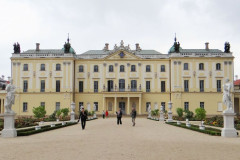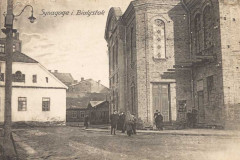Podlaskie province
Description
Podlaskie Voivodeship (Polish: Województwo podlaskie, [vɔjɛˈvut͡sfɔ pɔdˈlaskʲɛ]) is a voivodeship in northeastern Poland. It borders on Masovian Voivodeship to the west, Warmian-Masurian Voivodeship to the northwest, Lublin Voivodeship to the south, the Belarusian Voblasts of Grodno and Brest to the east, the Lithuanian Counties of Alytus and Marijampolė to the northeast, and the Kaliningrad Oblast of Russia to the north. Its capital is Białystok. It was created on January 1, 1999, out of the former Białystok and Łomża Voivodeships and the eastern half of the former Suwałki Voivodeship, pursuant to the Polish local government reforms adopted in 1998.
Etymology
The voivodeship takes its name from the historic region of Poland called Podlasie.
There are two opinions regarding the origin of the region's name. People often derive it from the Slavic les or las, meaning "forest", i.e., it is an area "by the wood(s)" or an "area of forests", which would bring Podlasie close in meaning to adjacent Polesia. This theory has been questioned, as it does not properly take into consideration the vowel shifts "a" > "e" > "i" in various Slavic languages (in fact, it mixes vowels form different languages). Heavily-wooded Podlasie is home to the primal Białowieża Forest and National Park, habitat of the European wisent bison and tarpan.
A second view holds that the term comes from the expression pod Lachem, i.e., "under the Poles" (see: Lechia). Some claim it to mean "under Polish rule", which does not seem historically sound, as the area belonged to the Grand Duchy of Lithuania until 1569, and the southern part of it—until 1795.
A better variant of the latter theory holds that the name originates from the period when the territory was within the Trakai Voivodeship of the Grand Duchy of Lithuania, along the border with Mazovia Province, primarily a fief of the Poland of the Piasts, and later part of the Kingdom of Poland of the Jagiellons. Hence pod Lachem would mean "near the Poles", "along the border with Poland". The historical Lithuanian name of the region, Palenkė, has exactly this meaning.
History
The voivodeship was created on January 1, 1999, out of the former Białystok and Łomża Voivodeships and the eastern half of the former Suwałki Voivodeship, pursuant to the Polish local government reforms adopted in 1998.
Geography
It has a varied landscape, shaped in the north by Baltic glaciation, the rest by Middle Poland glaciation. The highest peaks are in the north (Rowelska Top - 298 m), where the landscape is dominated by a hilly lake district. Lakeland: Zachodniosuwalskie, Wschodniosuwalskie, Ełckie) and Sandrowy lake district (Augustów Plain) in the central and southern pre-glacial plains prevail (plateaus: Kolneńska, Białystok, Wysokomazowiecka, Drohiczynska, Sokólskie Hills, Międzyrzecko łomżyński, Plain Bielsko), varied in topography with small basins and river valleys. Kurpie lie on the west edge of the outwash plains. Sand, gravel, clay, moraine, and in the valleys and basins of the rivers silt, sand and river peat predominate on the surface.
Environment
The vast forests (Białowieża, Augustów, Knyszyń, Kurpiowska), some of which are the only ones in Europe to have retained their original character, contain a unique wealth of flora and fauna. The vegetation of the region is extremely diverse, which contributes to the richness of the animal world. Visitors can also see moose, wolves, lynx and bison living in the Białowieża Forest and Knyszyń Forest.
Podlaskie has the lowest population density of the sixteen Polish voivodeships, and its largely unspoiled nature is one of its chief assets. Around 30% of the area of the voivodeship is under legal protection. The Polish part of the Białowieża Forest biosphere reserve (also a World Heritage Site) is in Podlaskie. There are four National Parks (Białowieża, Biebrza, Narew and Wigry), three Landscape Parks (Knyszyń Forest, Łomża and Suwałki), 88 nature reserves, and 15 protected landscape areas. The voivodeship constitutes a part of the ecologically clean area known as "the Green Lungs of Poland".
Transportation
Culture
Podlaskie is the most diverse of all Polish voivodships. The area has been inhabited for centuries by members of different nations and religions: Poles, Jews, Belarusians, Lithuanians, Ukrainians, Rusyns, Gypsies, Lipka Tatars and Filippians.
Many places of religious worship remain:
- An 18th-century former Carmelite monastery on Wigry Lake
- A former Jesuit complex in Drohiczyn
- Christ's Transfiguration Orthodox church on the Holy Mount of Grabarka
- Saint Nicolaus the Miracle Worker Orthodox church in Białystok
- A 17th-century synagogue in Tykocin
- The oldest Polish mosque in Kruszyniany
Historic sites
Middle Ages
- St. Michael and John the Baptist Church in Łomża (1504–26)
Renaissance
- The ruins of the Royal Castle in Tykocin (15th century)
- The Jewish cemetery in Tykocin (16th century)
- Monastery of the Annunciation in Suprasl (16th–18th centuries)
Baroque
- Dominican Convent of the Visitation of the Blessed Virgin Mary Church in Sejny (1610–19)
- Old Parish Church in Białystok (1617–26)
- Synagogue (1642) and the Talmud house in Tykocin (18th century)
- Trzewiczkowych Carmelite Monastery with the Church of Our Lady of Mount Caramel in Bielsk Podlaski (mid-17th century)
- Branicki Palace in Białystok (17th–18th centuries)
- Summer residence Branicki in Choroszcz (1752–59)
- Holy Trinity Church in Tykocin (1742–50)
- Church of the Assumption of the Virgin Mary in Siemiatycze (1719–27)
- Monastery of the Dominican church of St. And St. John the Baptist. Stephen Martyr in Choroszcz (mid-18th century)
- Capuchin Monastery in Łomża (1770–98)
- Old Town Hall in Bielsk Podlaski (1776–80)
- Sokółki Palace in Pawłowiczch near Sokółka
- Synagogue in Orla
- Bernardine Monastery in Tykocin (1771–91)
- The team Stawiski Franciscan monastery (17th-19th centuries)
Classicism
- Basilica. Birth of the Virgin and St. Nicholas in Bielsk Podlaski (1780)
- Cathedral of St.. Nicholas in Białystok (1843–46)
- Church of Sts. Kolnie Anne (1834–39)
- Co-cathedral of St. Alexander in Suwałki (1825)
- Classical brick mansion in Mały Płock (1835)
- Church of Sts. Anthony in Sokółka (1848)
- Cemetery Cathedral in Łomża
- Synagogue in Kolno (second half of 18th century)
19th century
- Lubomirski Palace in Białystok (second half of 19th century)
- Hasbach Palace in Białystok (late 19th century)
- The palace and park in Buchholtzów Suprasl (1892–1903)
- Team Becker factory in Białystok (19th and early 20th century)
- The fence and gate parafialno-municipal cemetery in Kolno (1809)
- Church in the Parish and (first half of 19th century)
- Catholic Parish in Grabowo (first half of 19th century)
- The Jewish cemetery in Kolno (1817)
- The Jewish cemetery in Stawiski (first half of 19th century)
- Parish Church p.w. St. Adalbert in m (first half of 19th century)
- The team mail Stawiski (2nd quarter of 19th century)
- Neo-Baroque bell tower at the church brick church. St. Anne Kolnie (1862)
- Buildings of the monastery of SS. Benedictine in Łomża (1863)
- Church of the Assumption in Łomża (1877)
- Roman Catholic Cemetery in Poryte (second half of 19th century)
- Church of the Holy Trinity in Zambrów (1879)
- Church of the Holy Trinity in Grajewo (1882)
- Church of Sts. John the Baptist in Wysokie Mazowiecki (1888)
- Building Seminar in Łomża(1866)
- Town Hall in Łomża (1822–23)
- Numerous monuments Street. Dwornej in Łomża
- Manor in Wojnówka
- Basilica of the Assumption in Białystok (1900–05, neo-Gothic)
- The Church of St.Adalbert in Białystok (1906–12)
- The Church of St. Rocha in Białystok (1926–47, modernist)
- Church of the Sacred Heart of Jesus in Augustów (1905–11 eclectic)
- The Church of Our Lady of Częstochowa and St. Casimir in Mońki (1921–35)
- Saints' Church of the Apostles Peter and Paul in Łapy (1918–27)
- Fortress in Osowiec
- Polish Tatar (see "Islam in Poland") wooden mosque and Muslim cemetery in the village of Bohoniki




